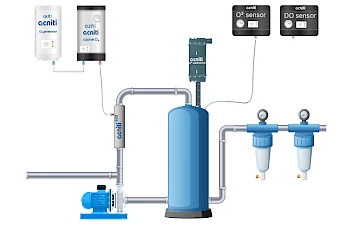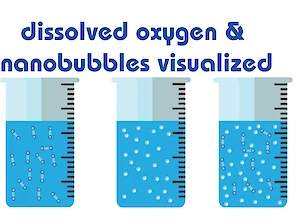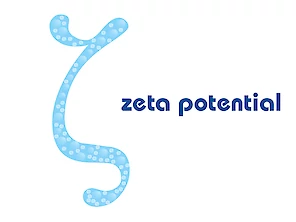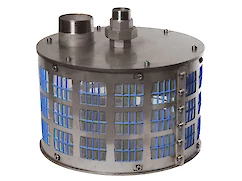Modified: Wednesday, 31 December 2025
Written by Erik van Berkum (LinkedIn)
Effective Drinking Water Treatment: The Power of Ozone
Introduction
Safe drinking water is a key necessity and ozonation is one of the common processes in drinking water preparation.
Ozone is a strong oxidant and one of the most powerful disinfectants available in water treatment, with the superior ability to kill viruses and biological contaminants found in water & thus is used in the potabilization of surface or ground water as well as in wastewater treatment to remove microorganisms, inorganic ions, and organic pollutants. Ozone is significantly more effective than chlorine at inactivating and / or killing viruses, bacteria, and cysts.
Ozonation for contaminated water

Ozone is also an effective treatment for taste, odor and color removal, iron, and manganese reduction, as well as being a flocculating agent.
It is an enormously powerful oxidant that can oxidize metals in water such as manganese, iron, and sulphur into insoluble particles, aiding in their filtration and removal from water. Iron & manganese removal is one of the more common uses for Ozone in drinking water system. Iron & manganese are easily oxidized by Ozone. Ozone oxides the iron, manganese, and sulfur in the water to form insoluble metal oxides or elemental sulfur. These insoluble particles are then removed by post-filtration.
Both Iron Fe(II) and Manganese Mn(II) are soluble (non-removable) in water causing them to flow directly through conventional filtration systems without some form of Oxidation to transform them into particulates (removable). Ozone oxidation of iron & manganese is an extremely fast reaction.
The soluble Iron Fe(II) called Ferrous Iron, available in water, is oxidized to Ferric Iron Fe(III) by Ozone. This Ferric Iron Fe(III) will then hydrolyze to form Fe(OH)3 , which is particulate & can be removed by standard filtration.
Similarly soluble Manganese Mn(II) in water, is oxidized by Ozone to form manganese dioxide MnO2, which is particulate & can be easily removed by standard filtration.
In addition to “Ozonation system”, you will also need a filtration system, with a back-washable filtration system, to remove this ‘particulate’ Iron & Manganese from water. Sand filters are widely used for iron & manganese. removal due to the uncomplicated design & long-lasting filter media.
Difficulties conventional wastewater systems

The main drawbacks of using conventional ozone methods are the high-buoyancy-related low retention time and rapid decomposition of ozone eradicating residual ozone in water. Ozone degrades over a period ranging from a few seconds to 30 minutes, depending on water chemistry, pH & water temperature.
Nanobubble treatment for water purification

Acniti Ultrafine bubble generator (Nano-bubbler), takes care of this limitation. The Ozone ultrafine bubbles generated by our system have much longer life / stability than the standard Ozonation system.
Ultrafine bubbles/ Nano bubbles are the smallest bubble size known, measuring less than 100nm. These bubbles have several unique characteristics related to their miniature size, like neutral buoyancy, a strong electric charge, and a high transfer efficiency, which makes them a superior aeration method for various applications. Standard aeration technologies, involving larger bubbles (micro bubbles), do not own these special characteristics, making them less beneficial, as compared to Nano bubbles.
When ozone is delivered as nano bubbles, it increases the retention time due to the low-rising-velocity-related low buoyancy and increased higher specific area of nano bubbles compared to those of ordinary/micro bubbles. The diffusion and concentration of ozone in the water are especially important in the treatment process. Results and theoretical calculations have shown that using nano bubbles leads to lower diffusion & higher ozone concentration compared to using ordinary (micro) bubbles. Decomposition of ozone in water generates oxygen where higher oxygen concentrations are obtained using nano bubbles. The oxygen formed during decomposition of ozone generates radicals that can oxidize pollutants.
acniti ozone filtration systems


ozonation system:
- Oxygen concentrator
- Ozone generator
- Turbiti (nanobubbles) mixer
- Ozone sensor
- Ozone destructor
common applications:
- Iron oxidation and filtration
- Manganese oxidation filtration
- Well water treatment
- Small water treatment plants







